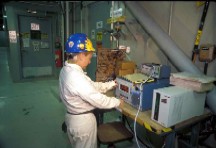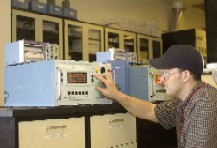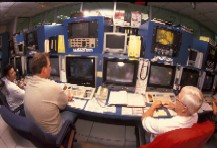- U.S. Congress mandates that outdated weapons be destroyed
- The U.S. ratifies the Chemical Weapons Convention Treaty
- Stockpile and nonstockpile chemical agent disposal
- Chapter 32, Chemical and Biological Warfare Program
- Section 1521, Destruction of existing stockpile of lethal chemical agents and munitions
- Section 1522, Conduct of chemical and biological defense program
- Section 1523, Annual report on chemical and biological warfare defense
Historical perspective
From World War I to 1968, the United States produced chemical weapons as a deterrent against use of similar weapons by other countries. Though never used in battle, these U.S.weapons are now obsolete and deteriorating with age.
U.S. Congress mandates that outdated chemical weapons be destroyed
In 1985, the U.S. Congress mandated that the Department of Defense be responsible for establishing a Chemical and Biological Defense (CDB) program, U.S. Code Title 50, Sections 1521 through 153, provided the legal foundation for chemical weapons disposal activities.
The Department of Defense was also responsible for ensuring maximum protection of the environment and the general public, as well as workers involved in chemical weapons destruction (Public Law 99-145, 1985 and U.S. Code 50, Section 1521).
|
|
|||
|
|||
|
|
|||
| The
U.S. signs the International Chemical Weapons Convention (CWC)
Treaty
In 1997, the United States ratified the United Nations International Chemical Weapons Convention treaty. By participating in the treaty, the United States agreed to destroy its stockpile of aging chemical weapons -- principally mustard agent and nerve agents -- by April 29, 2007. However, the final destruction deadline was extended to April 29, 2012, at the Eleventh Session of the Conference of the States Parties to the Chemical Weapons Convention at The Hague on December 8, 2006. Today, the U.S. Army is recognized as a world leader in international chemical weapons elimination efforts. Over a decade of experience has demonstrated that these weapons can be destroyed safely, without harm to employees, to the community, or to the environment. |
|||
|
|
|||
 |
|
||
|
|
|||
| Stockpile
and non-stockpile chemical warfare agent disposal
The U.S. national stockpile of lethal chemical warfare agents primarily involves six chemicals: GA Tabun or ethyl N,N-dimethyl phosphoroamidocyanidate, CAS 77-81-6 GB Sarin or isopropyl methylphosphonofluoridate, CAS 107-44-8 H, HD, HT Sulfur mustard, bis-(2-chloroethyl)sulfide, or di-2-chloroethyl sulfide (HD), CAS 505-60-2; bis(2-chloroethylthioethyl) ether (HT), CAS 63918-89-8 L Lewisite or dichloro 2-chlorovinylarsine, CAS 541-25-3 VX O-ethyl-S-(2-diisopropylaminoethyl)-methyl phosphonothiolate, CAS 50782-69-9 Years ago, the Department of Defense stored these agents, either in bulk containers or as assembled munitions, at various locations within the continental United States. The remainder of the stockpile was transferred to Johnston Atoll, a small remote island in the Pacific Ocean (Southwest of the Hawaiian Islands). Note that all chemical warfare agent materials previously stored on Johnston Atoll now have been destroyed. Non-stockpile chemical warfare materiel includes former chemical weapons production facilities; recovered chemical weapons, chemical samples, and binary chemical weapons; and miscellaneous equipment, such as empty aerial spray tanks. |
|||





